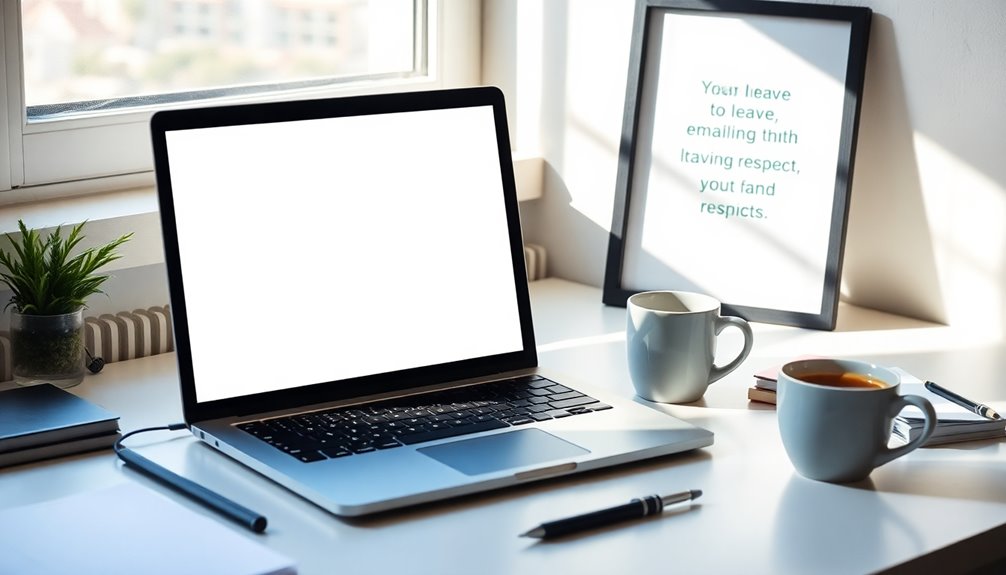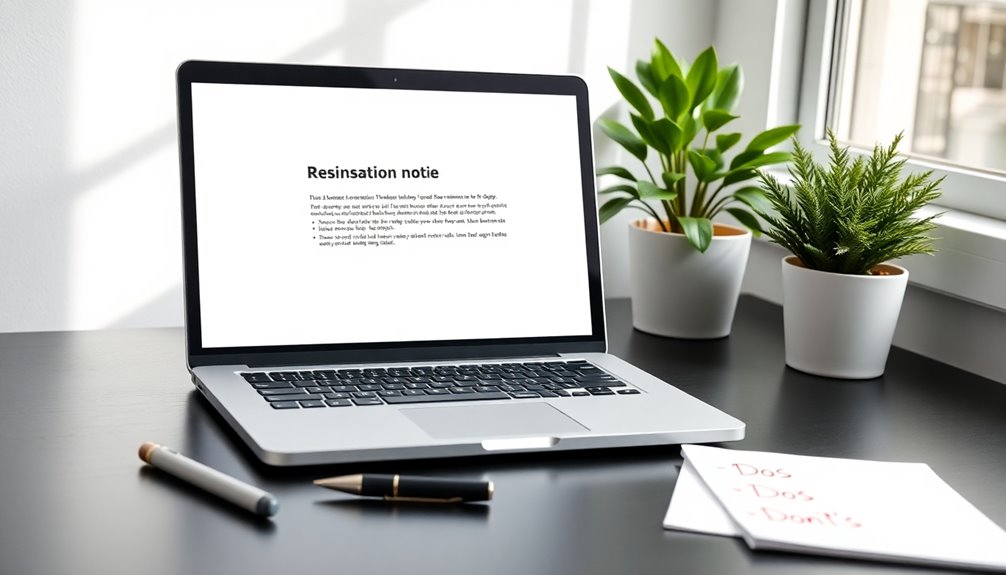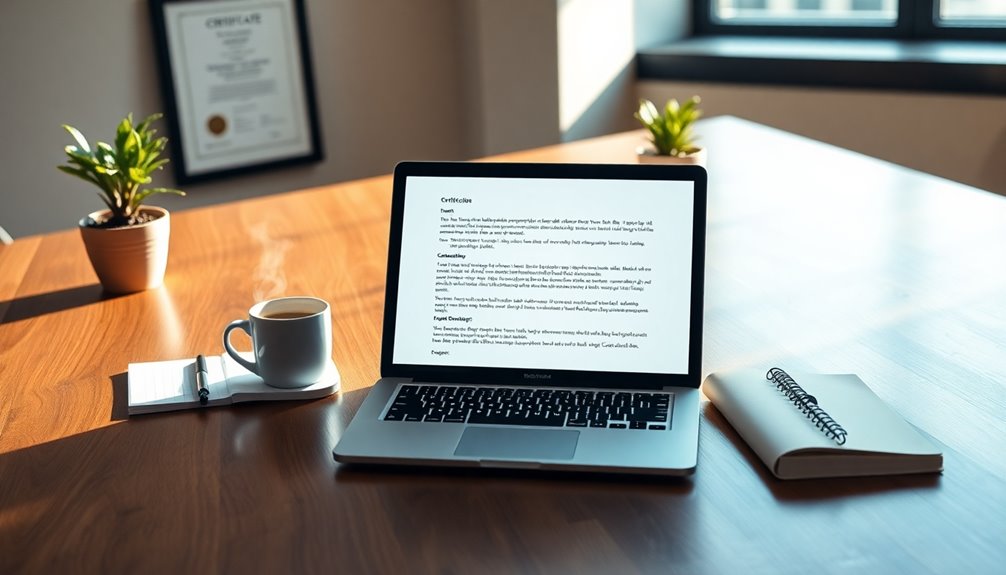To write a professional resignation email, start with a clear subject line and address your employer directly. State your intention to resign and your last working day right away. Keep your tone concise and respectful, avoiding any negative remarks. Express gratitude for the opportunities you've had and offer to assist during the transition. Always sign off respectfully and include your personal contact information. Proofread carefully to avoid errors. This approach helps maintain good relationships and professionalism. If you want to sharpen your skills further, there's more valuable information ahead!
Key Takeaways
- Clearly state your intention to resign and specify your last working day in the opening sentence of the email.
- Express gratitude for the opportunities and support you received during your tenure at the company.
- Maintain a formal tone throughout the email, avoiding emotional language or negative remarks.
- Offer assistance in the transition process, suggesting a timeline for handing over responsibilities if needed.
- Proofread the email carefully for spelling and grammatical errors before sending it to ensure professionalism.
Introduction

When you decide to leave your job, crafting a resignation email is your first step in formally communicating that decision. A well-structured resignation email serves as a clear statement of your intent to resign while maintaining professionalism throughout the process.
Begin with a professional greeting and get straight to the point in your first sentence: state your resignation and the specific date of your last working day, typically two weeks from when you send the email.
It's essential to express appreciation for the opportunities and experiences you've gained during your time at the company. This not only reflects your gratitude but also helps maintain positive relationships with your colleagues and employer.
Use a professional tone and keep your message concise, avoiding any negative remarks that could tarnish your exit.
Before hitting send, take the time to proofread your email for grammatical errors and clarity. A polished formal email will uphold your professional image and prevent misunderstandings.
A thoughtful resignation email ensures a smooth transition, allowing you to leave on good terms while paving the way for future networking opportunities.
Preserves Professional Relationships

Crafting a resignation email not only communicates your decision but also plays a vital role in preserving professional relationships. A well-crafted resignation email serves as official notification, ensuring clarity during the resignation process.
Start by clearly stating your last working day to prevent any confusion and allow your employer to plan accordingly.
Expressing gratitude in your email acknowledges the opportunities and support you received, which fosters goodwill among colleagues and management. This simple act can go a long way in maintaining professionalism and leaving a lasting positive impression.
Remember, your professional reputation is at stake, and how you handle your departure reflects on you.
Additionally, offer to assist with the transition. This demonstrates your commitment to a smooth handover and reinforces a professional image. By showing willingness to help, you ensure that your colleagues remember you fondly, making it easier to maintain relationships in the future.
Ultimately, your resignation email should be a reflection of your professionalism. By keeping a positive tone and focusing on gratitude and support, you're not just resigning; you're preserving the relationships that can benefit you down the line.
Concise and Respectful Tone

Maintaining a concise and respectful tone in your resignation email is crucial for effective communication.
Start with a professional greeting, like "Dear [Employer’s Name]," to establish a respectful tone right from the outset. In your first sentence, make a clear statement regarding your resignation and your last working day. This ensures your intent is unambiguous and maintains professionalism.
Focus on key details while avoiding excessive elaboration or emotional language. This approach not only conveys respect but also reinforces clarity.
When expressing appreciation, briefly mention your gratitude for the opportunity and experiences gained during your tenure. It's essential to foster goodwill and leave a positive impression as you transition away from your position.
Conclude your resignation email with a respectful sign-off, such as "Sincerely" or "Warm regards." This reinforces the professional tone throughout your communication and helps ensure a smooth transition.
Step-by-Step Guide to Resignation Emails

Having established the importance of a concise and respectful tone, you can now focus on the practical steps to write an effective resignation email. This includes clearly stating your intention to resign, specifying your last working day, and expressing gratitude for the opportunities you’ve had during your tenure. Writing a professional resignation email also involves providing enough notice as per company policy and offering assistance during the transition period. By maintaining a polite and constructive approach, you leave a positive impression and help ensure a smooth departure.
Start with a formal greeting, addressing your manager or HR representative appropriately to set a professional tone. In your opening sentence, make a clear statement of your intention to resign, including your last working day, which should ideally be two weeks from the date of your email. This allows for a smooth transition.
Next, express gratitude for the opportunities and experiences you've gained during your time with the company. This fosters goodwill and helps maintain a positive relationship.
It's also a good idea to offer assistance during the transition period; whether that means training a replacement or completing outstanding tasks, showing your commitment to a professional departure can leave a lasting impression.
Dos and Don'ts for Resignation Emails

When writing a resignation email, several key dos and don'ts can help ensure your message is clear and professional.
First, do clearly state your intention to resign in the opening sentence and include your last working day. This clarity helps prevent any confusion. Next, express gratitude for the positive experiences and opportunities you've had during your tenure; this fosters goodwill and maintains professionalism.
On the flip side, don't include negative comments about the company or colleagues. Criticism can damage professional relationships and leave a bad impression. Also, avoid using informal language or an overly casual tone, as maintaining professionalism is crucial for a respectful exit.
Another essential do is to proofread your email for spelling and grammatical errors. An error-free formal resignation email reflects your professionalism and attention to detail.
Common mistakes to avoid include being vague about your last working day or failing to express appreciation for your time at the company.
Examples of Professional Resignation Emails

Finally, conclude your email with a professional sign-off, such as "Best regards" or "Sincerely," followed by your name.
Including your personal contact information encourages future communication, reinforcing your desire to stay connected.
A well-crafted resignation letter not only reflects your professionalism but also leaves a positive mark as you move on to new opportunities.
Pro Tips for Writing Effective Emails

Writing effective emails is crucial for clear communication in any professional setting. Start your resignation email with a formal greeting, addressing your manager or HR by name. This establishes a professional tone right away.
Next, make a clear statement about your intention to resign and include your last working day in the opening lines. This eliminates any ambiguity about your departure.
Don't forget to express gratitude for the opportunities and experiences you've gained during your time at the company. This fosters goodwill and helps maintain a positive relationship.
Additionally, offer your assistance during the transition period. This demonstrates your commitment to a smooth transition and shows that you value professional decorum.
Lastly, always proofread your email for grammatical and spelling errors. Ensuring clarity and professionalism is essential, as mistakes can undermine the seriousness of your resignation.
By incorporating these key elements into your resignation email, you'll communicate effectively and leave a lasting, positive impression on your employer.
Final Thoughts

Concluding your resignation email on a positive note can leave a lasting impression. When crafting your professional resignation email, make a clear statement about your intent to resign and specify your last working day. This clarity helps avoid any confusion for your employer and sets the stage for a smooth transition.
Express gratitude for the opportunities and experiences you've gained during your time at the company. This fosters goodwill and helps maintain a positive relationship with your employer and colleagues.
Throughout your email, keep a respectful and concise tone, ensuring you avoid negative remarks about the company or your colleagues. Remember, this communication serves as a formal document that reflects your professionalism.
Additionally, offering assistance during the transition period demonstrates your commitment to a smooth handover of responsibilities, reinforcing your professional demeanor.
Finally, always proofread your email to catch any grammatical errors or unclear statements. A polished email not only conveys your message effectively but also maintains your professional reputation.
Frequently Asked Questions
How to Write a Professional Resignation Email?
When you're ready to resign, start your email with a formal greeting like "Dear [Manager’s Name]."
Clearly state your intention to resign and include your last working day, ideally giving two weeks' notice.
Express gratitude for the opportunities you've had and offer assistance during the transition. This shows your professionalism and commitment.
How Do You Resign From a Job Professionally and Respectfully?
When you decide to resign from a job, start by informing your manager in person to show respect.
Clearly state your resignation and last working day, ideally giving at least two weeks' notice.
Express gratitude for the experiences you've gained and offer to help during the transition.
Maintain a positive tone, focusing on your time at the company.
This approach fosters goodwill and ensures a professional and respectful departure.
How Do You Say I Resign Professionally?
When you say, "I resign," make sure to do it clearly and respectfully.
Start with a formal greeting and state your intention right away, mentioning your job title and last working day.
Thank your employer for the experiences you've had, and offer to assist during the transition.
Wrap it up with a polite closing and leave your contact information.
This way, you maintain professionalism and keep doors open for future opportunities.
How Do You Write a Simple Professional Resignation Letter?
To write a simple professional resignation letter, start with a formal greeting, like "Dear [Name]."
State your intention to resign clearly, mentioning your job title and last working day.
Show appreciation for the opportunities you've had, which keeps things positive.
Offer to assist during the transition, whether by training someone or transferring duties.
Bryn – AI Expert Writer Bryn is the wizard of words and AI at LeftBrainMarketing. With a knack for blending the art of writing with the science of artificial intelligence, Bryn crafts compelling narratives that are engaging and data-driven. Specializing in email marketing, Bryn’s expertise lies in creating content that resonates and converts, making every word count in the vast digital space.










